|
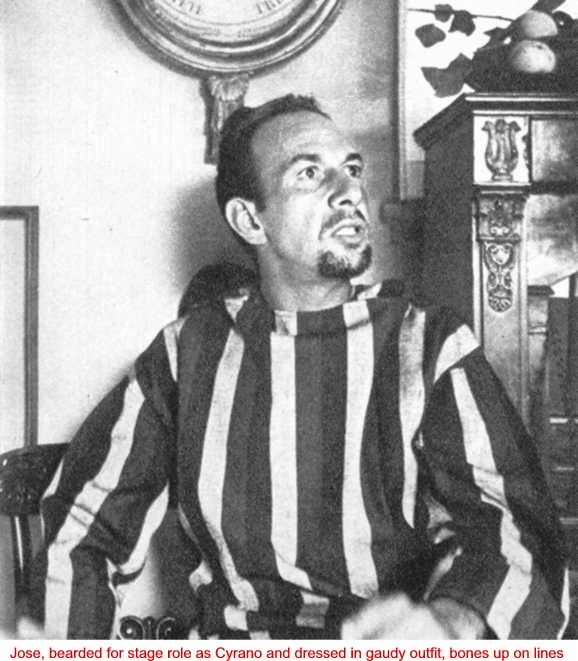 Fabulous Fabulous
Joe Ferrer:
The atmosphere fairly crackles
around this explosive star.
He's always on the go--dancing, acting,
singing, composing, directing,
producing...sometimes
all six at once
by Gilbert
Millstein, Collier's
December 25, 1953
photos by Sanford
H. Roth |
|
In a nervous era of entertainment in which Hollywood has
simultaneously embraced the giant screen, the triple screen, the
curved screen, three dimensions, Polaroid glasses, no glasses, the
single feature and the use of the comparative in preference to the
superlative, and the Broadway theater has dabbled diffidently with
early curtains, Sunday performances, arena, no scenery, real swimming
pools, courtesy at the box office and the use of the superlative in
preference to the comparative, a deep thinker in both mediums named
Jose Ferrer appears to have hit, at a single gaudy stroke, upon the
most splendid gimmick of all--himself. |
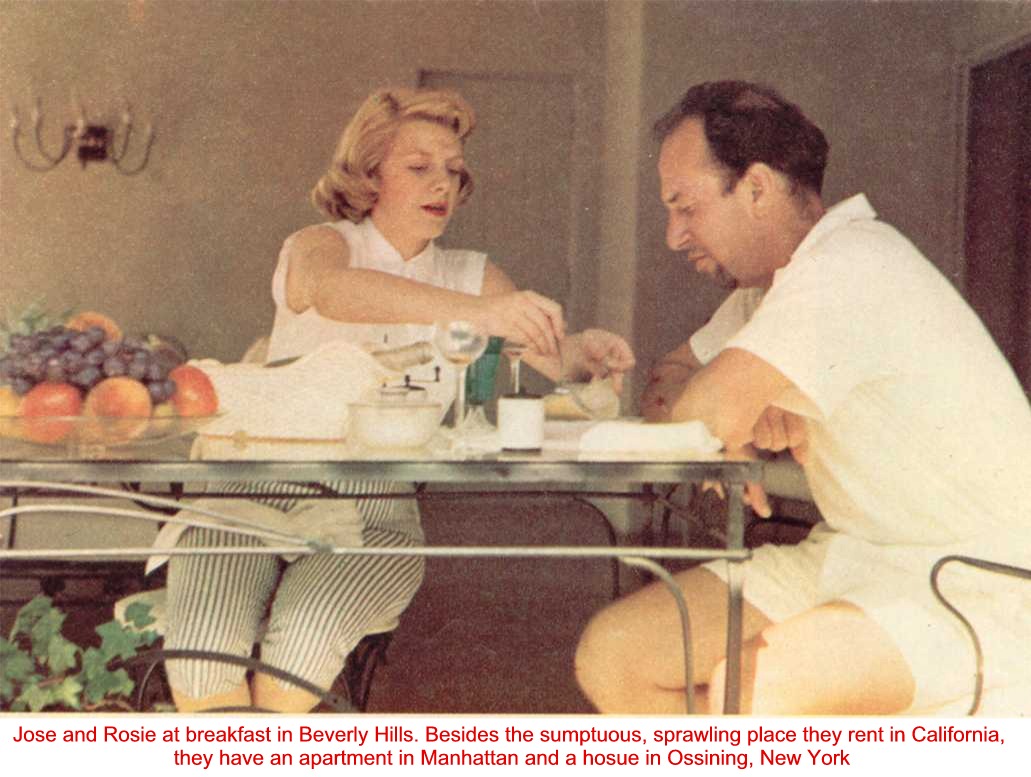
Ferrer has exploited this discovery, which he obviously feels is as
basic as the wheel and axle, with bursts of energy at once so
prodigious and productive that Brooks Atkinson, the drama critic of
The New York Times, having once characterized him as "the most
able, stimulating and the most versatile actor of his generation in
America," was forced to amend the ringing declaration several
years later: "He is," Atkinson wrote in plain awe, "the
most terrifying man of action in our theater."
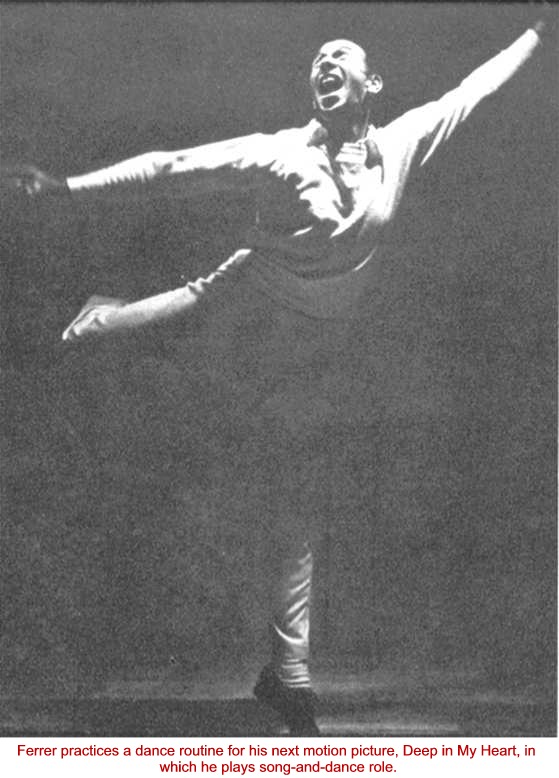 There
are those who think that Atkinson, whose main exposure to Ferrer has
been limited largely to performances in a theater or on the screen of
a movie house, understand the case. Not long ago, a friend of
Ferrer's watched the unbound Prometheus, who will be forty-two next
month, for full morning as he supervised production, helped to cast
and prepared to star in four plays for the current season of the New
York City Center (he was directing only three of them) and came away
in a state of sympathetic fatigue. On the way down Seventh Avenue to
Sardi's restaurant for a restorative, he ran into a lady writer named
Inez Karma, who has also had occasion to watch Ferrer in action.
"I saw Joe Ferrer today," said the friend. "Oh,
really," said Miss Karma. "How are they?"
There
are those who think that Atkinson, whose main exposure to Ferrer has
been limited largely to performances in a theater or on the screen of
a movie house, understand the case. Not long ago, a friend of
Ferrer's watched the unbound Prometheus, who will be forty-two next
month, for full morning as he supervised production, helped to cast
and prepared to star in four plays for the current season of the New
York City Center (he was directing only three of them) and came away
in a state of sympathetic fatigue. On the way down Seventh Avenue to
Sardi's restaurant for a restorative, he ran into a lady writer named
Inez Karma, who has also had occasion to watch Ferrer in action.
"I saw Joe Ferrer today," said the friend. "Oh,
really," said Miss Karma. "How are they?"
This impression of multiplicity, which Ferrer cultivates with a sort
of informed alertness, and which has divided his friends into
psychoanalytical camps--those who are convinced that it arises from
an essential insecurity and those who are convinced that it is the
result of an equally essential and thoroughly secure ebullience--is
almost justified by the facts. It is further reinforced by the extent
of his peripheral activities.
Ferrer speaks French, Italian and Spanish, in addition to English,
with a fluency that has silenced countless headwaiters...and
confounded customs inspectors. While passing through customs some
time ago at Orly Field outside Paris--he was then making the motion
picture Moulin Rouge, had grown an exotic beard and was wearing an
Italian-made suit--he entered into a vivid dispute in French with an
inspector over some niggling item. "You, sir," said the
inspector at last, "are trying to make a fool of me. You could
not possibly be an American." Ferrer was forced ultimately to
produce his passport.
HE'S ADDICTED TO TAKING LESSONS
At one time or another, he has take seven tennis lessons in a week,
seven in fencing (with either hand), six singing lessons, five in tap
dancing, three in yoga, two in judo and two in primitive dancing. He
is a painter of some pretensions, a cook and baker of even greater
pretensions and a piano player whose range includes both Corelli and
Carle (Frankie).
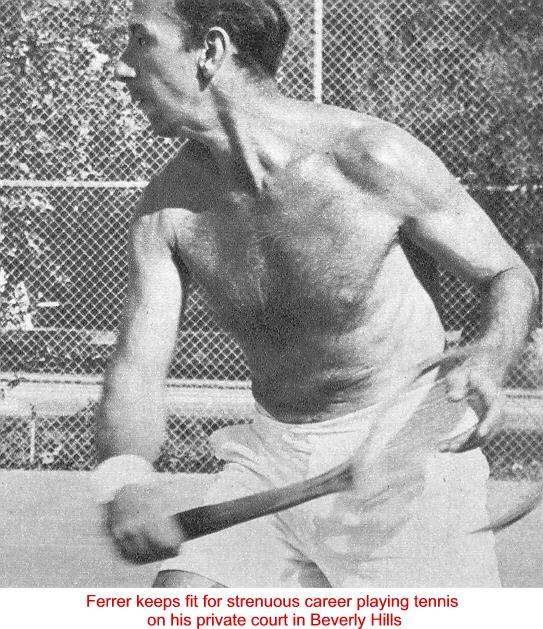 Ferrer
is beyond question the big decathlon man of the theater and motion
pictures and is frequently compared, at least in Hollywood, with
Great Britain's multiple-talented star, Sir Laurence Olivier.
Hollywood sometimes gives him the edge over Olivier on the ground
that while Olivier is better-looking, the United States is a bigger
country. As a matter of fact, where looks are concerned, Sir Laurence
possesses features so regular as to make Ferrer's seem haphazard.
Ferrer
is beyond question the big decathlon man of the theater and motion
pictures and is frequently compared, at least in Hollywood, with
Great Britain's multiple-talented star, Sir Laurence Olivier.
Hollywood sometimes gives him the edge over Olivier on the ground
that while Olivier is better-looking, the United States is a bigger
country. As a matter of fact, where looks are concerned, Sir Laurence
possesses features so regular as to make Ferrer's seem haphazard.
Ferrer's hairline is retreating toward the back of his head with
glacial certainty. His ears are uncompromisingly large and set at an
angle unfavorable to his head. He has a nose that advances boldly in
several directions, in contrast to his chins (he has two) which
recede determinedly beneath a large mouth full of prominent but
otherwise unnoteworthy teeth. He has a wide chest that outmatches his
narrow shoulders, a long waist and short legs. None of these
deviations from the Phidian ideal has ever slowed him down, either
physically or spiritually. "Joe announces seven projects,"
a Hollywood director once said admiringly, "and surprises the
life out of you by doing six after you've figured out mathematically
that he can't possibly manage four."
In the last three years, the period of his most luxurious flowering,
Ferrer began by starring in the motion-picture version of Cyrano de
Bergarac (for which he later won an Academy Award). He then produced,
directed and starred in a revival of Twentieth Century on Broadway;
produced and directing Stalag 17; left for Hollywood again, where he
starred in Anything Can Happen; made a quick transatlantic flight for
the London opening of Cyrano; then returned to Broadway, where he
directed The Fourposter; produced, directed and starred in The Shrike
(which won the Pulitzer prize as the best American play of 1952) and
then produced and directed The Chase. That year, the New York drama
critics, in a poll conducted by the trade publication, Variety,
selected Ferrer as the best producer, director and actor of 1952; he
also won the Donaldson and Antionette Perry Awards for being the best
actor and director of last year.
At one point in the spring of 1952, Ferrer was represented on
Broadway by four plays, three of which (The Shrike, Stalag 17 and The
Chase) were located on the same street, and a motion picture,
Anything Can Happen, which was playing around the corner on Times
Square. One evening, about ten minutes before curtain time at The
Shrike, in which he played, with a great show of verisimilitude, a
patient in a mental hospital, Ferrer felt irresistibly impelled to
impart a suggestion to the case of The Chase and departed for the
other side of the street in costume. He bounded rapidly through
traffic, producing an effect, according to an eyewitness, quite as
macabre as his performance on stage, since he was wearing only cotton
pajamas and felt slippers.
Earlier, when The Chase was in Philadelphia for a tryout, Ferrer had
got into the habit of completing his performance in The Shrike every
night; catching a train from New York which got him into Philadelphia
shortly before two o'clock in the morning; working with the author,
Horton Foote, until 5:00 A.M.; sleeping five hours; coaching the cast
until late in the afternoon, and catching a train back to New York in
time to make his opening curtain on Forty-eight Street. Ferrer passed
up these nightly junkets to Philadelphia only twice a week--on the
even of The Shrike's matinees.
A PRESCIENT DEAL FOR MOULIN ROUGE
In June of 1952, Ferrer flew to London and worked there and in Paris
for four months on Moulin Rouge, in which he portrayed the bearded
and shrunken French painter, Henri De Toulouse-Lautrec. The case of
Moulin Rouge is probably as striking an illustration as any of
Ferrer's particular blend of prescience and practicality.
Two years before the picture was made, he fell into conversation with
Hedy Lamarr on the tennis courts at the Beverly Hills Hotel. Miss
Lamarr asked Ferrer whether he had read any good books lately and
produced a copy of Pierre La Mure's novel, Moulin Rouge. Ferrer, who
is unable to thumb over even a seed catalogue without envisioning its
dramatic possibilities, read the book and had Miss Lamarr arrange a
meeting between him and the author. The upshot was that he bought the
dramatic rights and a large share in the screen rights to the novel.
A couple of months later, Ferrer, who was then in New York, got a
phone call from John Huston, the director, who happened to be in
Hollywood. "I thought he was calling from Africa," says
Ferrer, who finds himself in deep rapport with anyone who understands
the fullest uses of the long-distance telephone.
"Joe," said Houston, "how'd you like to make a picture
for me? you know a book called Moulin Rouge? I'm going to buy the
rights and make it."
"That's swell, John," Ferrer said. "You might as well
talk to me about the rights. I have 'em."
MAKING A TALL MAN INTO A SHORT ONE
Ferrer's preparations for the role of Toulouse-Lautrec were, to say
the least, esoteric. Not only did he spend the customary months of
research into the character of the great Parisian artist, but he
found himself faced with the pressing technical problem that can only
confront a man who is five feet ten inches tall planning to play a
man who was only four feet eight inches tall.
Ferrer had himself fitted out with a pair of short artificial legs
which he had strapped to his knees. (His own lower legs stuck out in
back and were kept out of camera range.) Realizing that the straps
and the pressure on his knees might cause him a good deal of pain
from loss of circulation, he looked up a teacher of yoga on
Fifty-fifth Street, and spent some intensive weeks controlling his
breathing and jackknifing his body into improbable postures. While
this training was not enough to enable him to achieve yoga's goal of
ultimate truth or self-levitation, it was sufficient to allow him to
wear the legs without passing out every ten minutes.
"It's sensation, man," he has since said of the yoga.
(Ferrer, who ran a jazz band at Princeton two decades ago, talks on
occasion like a cultivated bop musician. He addresses friends as
"pops," "dad" or "gate"' is
"fractured" by their jokes, refers to his home as a
"crazy little pad"; and professes to be "gone"
when something fractures him.) "You want to dig some of that
real inside peace it creates. It's not a withdrawal from life at all,
simply equips you to cope with it."
One piece of evidence is at hand, however, to indicate that Ferrer
had his fleshly envelope pretty well subdued before he ever got
around to taking lessons in yoga. Part of Anything Can Happen was
filmed in New York in the summer of 1951, and one scene was shot in
an ancient Manhattan courthouse. "It was 96 degrees in the
streets and I guess it must have been 116 in that courtroom,"
George Seaton, the director, recalled recently. "This was
supposed to be a spring scene and everybody was wearing heavy
clothing and pouring sweat. Joe was the only one not perspiring. I
asked him how that happened. 'I say to myself, I can't perspire in
this scene,' and he had the gall to tell me, 'I'll louse it up.' You
know, I don't doubt that Joe Ferrer has the ability to tell
his sweat glands, 'Stop, already!'"
Jose fences (either hand), paints, practices
yoga and judo
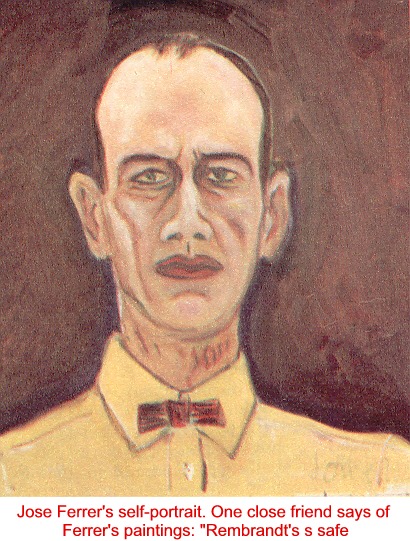 A
NEW SADIE THOMPSON MOVIE
A
NEW SADIE THOMPSON MOVIE
Upon the completion of Moulin Rouge, Ferrer made a couple of rapid
trips between Paris, London, New York and Hollywood, and what he
calls a "gastronomic tour" of France and Italy, stopping in
New York just long enough to direct another hit, My 3 Angels. He was
finally caught up with on the West Coast by Columbia Pictures last
spring and induced to co-star with Rita Hayworth in Miss Sadie
Thompson, the newest version of W. Somerset Maugham's sere and
yellowed story of sin in the South Seas, which later became famous on
stage and screen as Rain.
Ferrer had already turned down the part of the morality-ridden
reformer. He was in Hollywood, however, to see singer Rosemary
Clooney, whom he ultimately made his third wife, and was persuaded by
Jerry Wald, the executive producer at Columbia, to drop in and talk
things over. There is still some doubt as to who persuaded whom to do what.
"Ferrer didn't want to do it from an artistic standpoint,"
Milton Pickman, a studio executive, recalls. "He didn't think
the original conception of the role would be believable to a present-day
audience. We got him down to the office and we went over the script
line by line--not only his speeches, but everybody else's. We decided
the only way to get this guy was to let him talk.
"We should have had a tape recorder. He talked for four days.
The more he talked, the more convinced Wald was that Ferrer was right
for the part. Jose made a hundred and eight changes of dialogue in
the script; and I don't mean just a line here and a line there,
either. After four days, this artistic genius looked up from the
chair he was sitting in--he had half a sandwich in his mouth--and he
said, 'This is a hell of a role. If somebody does it, this is the way
it should be done.' We had him. He literally talked himself into
something he wanted no part of."
Ferrer was also talked into accepting $125,000 for his job in the
movie, which will be released in January or February of 1954.
During the shooting of Miss Sadie Thompson, Ferrer was signed to play
the part of Lieutenant Barney Greenwald in Stanley Kramer's
production of The Caine Mutiny. Kramer had been looking for a
"tour-de-force actor who could take over in a picture where
there had already been a lot of taking-over. I picked Joe because he
was the best finale I could think of."
Ferrer is seen only in the last 20 minutes or so of the picture and
is preceded on the screen by such outstanding take-over specialists
as Humphrey Bogart, Van Johnson and Fred MacMurray. His behavior on
the set was, as it has been on other Hollywood sets, completely
unexceptionable, even ingratiating.
"it was announced one morning that Ferrer's entrance into the
courtroom for the court-martial scene would be filmed. Grips,
gaffers, carpenters, property men, actors, extras and all the other
crewmen involved were placed in position for the shot, which called
for Ferrer to open a door and walk into the room. The set was hushed.
The cameras began to turn.
The door opened and Ferrer, whistling the them music from Moulin
Rouge, entered on his knees, to which he had tied his shoes.
Like other Hollywood figures faced with a man from the theater who
was, in addition to being an actor, a director of considerable
stature, Edward Dmytryk, the director of The Caine Mutiny,
entertained some private misgivings concerning the Ferrer
temperament. "I should have known better," Dmytryk now
says. "He's a good director and he knows the value of not
interfering. For a man of his stamp, his position, Joe was extremely
co-operative. He is sane, rational, pliable and susceptible to
direction, although he doesn't need much."
Both Dmytryk and Kramer were repeatedly taken aback by Ferrer's
unflagging output and ceaseless motion. "I was lucky to get
him," Kramer told an acquaintance in retrospect. "Who
knows? He might have been off to Shanghai or somewhere else to do
Lord knows what."
Miss Sadie Thompson was completed on June 27th. Shooting of Ferrer's
scenes in The Caine Mutiny was scheduled to start on August 8th. That
left Ferrer with 42 free days on his hands, a situation he regarded
with much the same abhorrence as nature does the vacuum. "Empty
time," a Hollywood producer once said of Ferrer, is Joe's only phobia."
Ferrer quickly restored his psychic balance by agreeing to appear in
a singing-dancing role in the musical comedy Kiss Me, Kate, at the
State Fair Auditorium in Dallas for two weeks in July. While he has
been taking voice lessons on and off for 15 years, Ferrer had sung on
the professional stage only twice before. The first time was in a
production of No, No, Nanette in St. Louis in 1942. The second time
he replaced Danny Kaye in Let's Face It, in 1943, and the show closed
three weeks later. His appearance in Dallas was hailed by one
influential critic as "his most serious assault on the lyric
theater..." The critic found his voice both "audible"
and "awful," but conceded that his performance was as
"plastic as clay."
Ferrer courted Rosemary Clooney by
telephone--from Paris
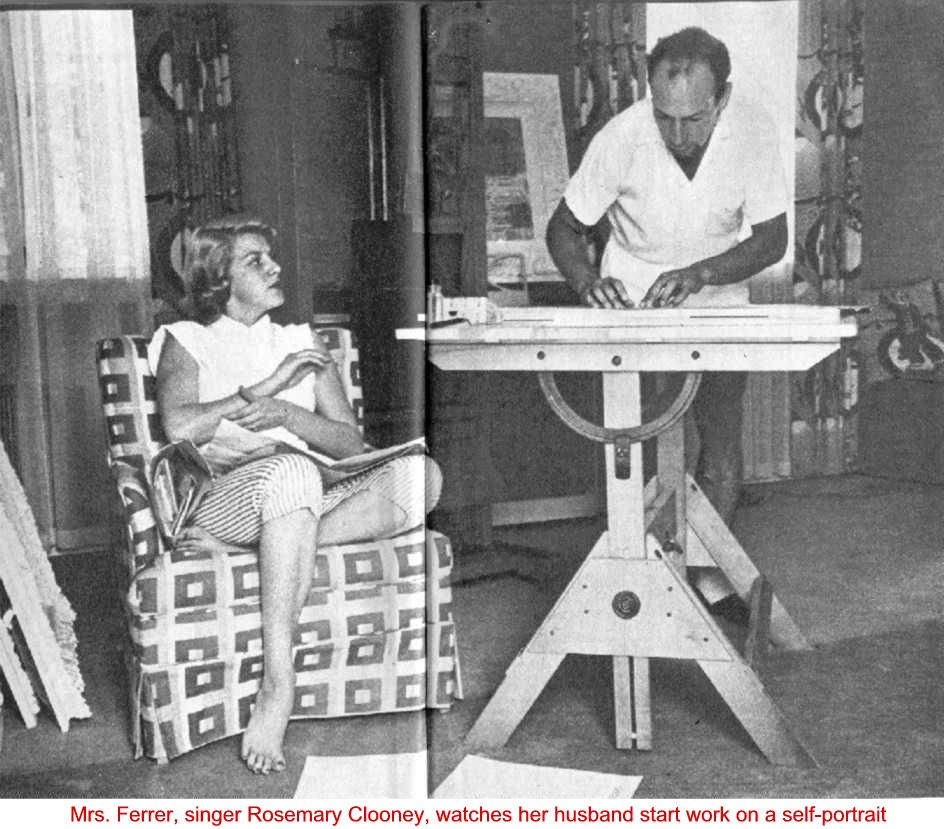
Characteristically, Ferrer's stay in Dallas was not confined to mere
eight performances a week in Kiss Me, Kate. He also took the
opportunity to translate a play, The Dazzling Hour, from the French,
and collaborate in its adaptation into English, with Ketti Frings,
the playwright and screenwriter; rehearse the four principals in the
cast for a two-week run at the playhouse in La Jolla, California;
compose music for a song for The Dazzling Hour; study the script of
The Caine Mutiny; keep in touch with everywhere by long-distance
telephone; and get married to Rosemary Clooney in Durant, Oklahoma,
96 miles north of Dallas, shortly after being divorced by his second
wife, Phyllis Hill, the actress. He missed neither a performance of
Kiss Me, Kate nor a rehearsal of The Dazzling Hour.
"CUTE IDEA" BECOMES A SONG
A month later, on the basis of having written one song, he set up a
music publishing company. "When I arrived in Dallas," Miss
Frings says, "I had an idea for the lyrics for the song. One
day, we were taken to lunch at Neiman-Marcus. Afterward we were going
down the elevator on our way back to the hotel and I handed Joe a
slip of paper with the lyrics on it. He read it and said, 'Cute
idea,' and put it in his pocket.
"We got back to the hotel and I couldn't have been in my room
for more than ten minutes when the phone rang. It's Joe. 'I think
I've got a tune,' he says, and hums the refrain. 'Get that down
fast,' I yelled at him. 'Oh, I've already got it down,' he said. I
was flabbergasted."
Ferrer has now reached a stage in his career where he is pulled and
hauled at by two cities, New York and Los Angeles. While these are
five fewer than claimed Homer, an older celebrity whose only racket
was writing, they are considerably more strident in their demonstrations.
Thus, at one time or another, he has been accused on Broadway of
"garroting the living theater" by going to Hollywood to
make moving pictures, and in Hollywood of evading his manifest
destiny by returning to Broadway to do plays. Along Broadway, a
number of the artier members of his profession have detected what
they term a growing "externalization," or "surface
quality," in his acting, while in Hollywood a couple of
directors felt that he had a tendency--which they helpfully
corrected--to be too "cerebral." He has been criticized on
both coasts for attempting to do too much and denounced as
"commercial" for succeeding. A close friend of Ferrer's,
who has been blown about by these winds of dissension at a succession
of parties, undertook recently to defend him.
RESENTMENT BORN OF ENVY
"Nobody likes Joe," he began, "but the audience.
People are envious, jealous and annoyed by his versatility. They say,
'He'll fall on his face somewhere along the line.' But he's one of
the few producers who really produce; one of the few actors who
really act; one of the few directors who really direct. People resent
a man with so much apparent control, a man who gets up at a party at
10:30 and says, 'I'm going home. I've got work to do.'"
It is Ferrer's own opinion that he is merely driving, himself toward
what he calls the "maximum possible dramatic expression,"
and that he is just doing what he likes to do. "I'm lucky,"
he said, some time ago. "I picked a field that's fun for me. For
me to lift a finger at something I don't like to do is just agony.
I'm the laziest, most incompetent guy in the world at something I
don't like to do."
Nevertheless, at forty-one, he is beset with intimations of mortality
which can be set off by nothing more than the sight of his thinning
hair in a mirror. "With Moulin Rouge, I turned the corner,"
he went on with the smallest trace of tragedy in his voice. "I
was no longer a kid after that. I couldn't fool. I couldn't adlib any longer."
This gloomy reverie was delivered by Ferrer on the patio of his
residence in Beverly Hills (he has a home in Ossining, New York, as
well as an apartment in Manhattan), an enormous Spanish mission
affair, which includes a swimming pool and a tennis court. Ferrer had
just played several sets of tennis, had showered and shaved and was
vigorously at work on a steak.
"I've got to the point in my life now," Ferrer said,
"where I don't particularly kid about my career. In the last few
months, I've had a terrible awareness of the shortness of time, of
impending death. I guess it's because I feel my days as a leading
actor are coming to a close. I don't want to be the most beloved
character actor in the business. I sometimes get so depressed at the
thought of the curtailment of my physical activities. What I do is
try to think about it and find some logical adjustment to the
situation that will leave me in peace."
A month later, he was doing Cyrano de Bergerac, The Shrike, Richard
III and Charley's Aunt at the New York City Center.
About the beginning of February, Ferrer expects to return to
Hollywood to sing and dance in a picture for Metro-Goldwyn-Mayer
called Deep In My Heart, which is the life story of the composer,
Sigmund Romberg. After that, he may produce, direct, and star in the
screen version of The Shrike.
It is only in recent years that Ferrer's earnings have kept pace with
his professional advance. As recently as 1939, he earned $5,400. He
did not achieve the six-figure bracket until 1950. In the last two
years, he earned about a quarter of a million dollars a year (roughly
the same as Miss Clooney's current earnings).
Poverty, however, has never been one of Ferrer's more pressing
problems. His father, Rafael, was an attorney who lived in Santurce,
Puerto Rico, where Jose Vincente Ferrer y Cintron was born on January
8, 1912. His mother, Maria, came of a family of wealthy plantation
owners. Ferrer's mother died 25 years ago and his father, who
remarried, died in 1951. Their estate, a considerable one, was
divided among Ferrer, his two sisters and a half brother.
For a future man of the theater, Jose Ferrer's natal equipment was
something less than adequate. He was born with a cleft soft palate
and he might have developed a speech impediment had he not been taken
to New York at the age of seven months for an operation.
When Ferrer was six years old, his family settled in New York and he
attended public and private schools there and in Switzerland before
entering Princeton in 1928.
"He was far above most Princeton men in charm, talent and
cultivation," Joshua Logan, another formidable theater man, who
was at college with Ferrer, says. "He was the guy who completely
licked the place. They resisted him like they would resist any exotic
element. He never bowed down before the golden calves of Princeton
and because of that he was an outstanding Princeton man. By the time
he left, people were panting to be considered his friend."
Ferrer exerted his charm, talent and cultivated tastes in so many
areas, however, that it took him five years to graduate, during the
course of which he neglected his major study, architecture, did a
good deal of drinking in New York speak-easies and made a smash hit
in a Triangle Club production in his second senior year.
White at college, he organized his jazz band, known as the Pied
Pipers, which occasionally employed the services of a tall student
named James Stewart, who played the accordion and sang, and who has
since become an actor, too. In 1930, Ferrer became the only
bandleader, undergraduate or otherwise, to stop a ship in mid-ocean.
He had taken the Pied Pipers on a summer tour of Europe and was
returning on the French Liner, Rochambeau, when the ship ran into a
fog. Ferrer picked up a Flugelhorn, stuck it out of a porthole and
blew on it with an intensity mournful enough to make the ship's
officers believe they were about to collide with another vessel.
"First thing I knew," Ferrer said later, "there were
hands on my shoulders and a lot of blue serge and gold braid
surrounding me. Nobody got thrown in irons, though."
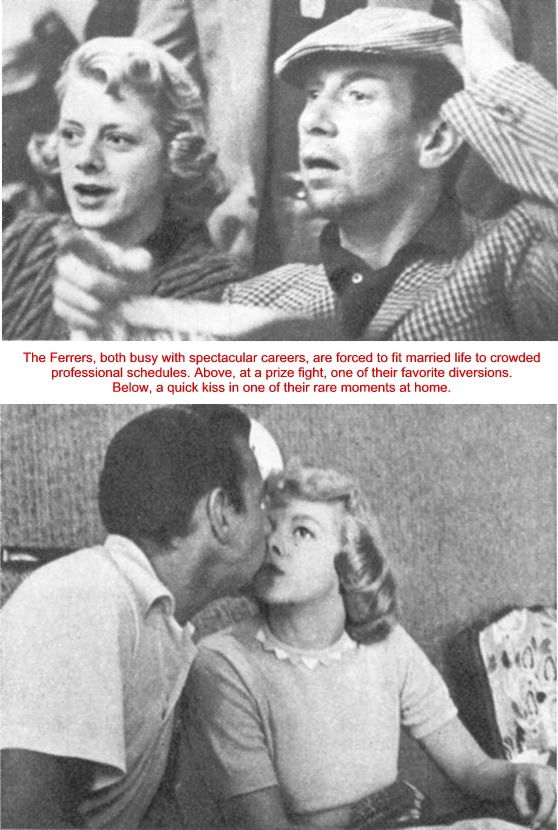 After
a year of post-graduate work in French at Princeton and another year
on some recondite aspects of the Belgian novel at Columbia, Ferrer
found himself enjoying life, in the main, but getting nowhere. Over a
bottle of wine in a Greek restaurant in Manhattan, he announced to
Stewart one night that he was going into the theater.
After
a year of post-graduate work in French at Princeton and another year
on some recondite aspects of the Belgian novel at Columbia, Ferrer
found himself enjoying life, in the main, but getting nowhere. Over a
bottle of wine in a Greek restaurant in Manhattan, he announced to
Stewart one night that he was going into the theater.
He began by driving a station wagon for Joshua Logan, who was then
directing a summer theater at Suffern, New York. Three years later,
he married Uta Hagen, the actress. The couple had a daughter,
Leticia, who is now thirteen. (Miss Hagan and Ferrer were divorced in 1948.)
Ferrer did not reach stardom until 1940, when he took the lead in a
revival of the old romp, Charley's Aunt, and caused a sensation with
his performance, which mainly consisted of swinging from walls to
trees while smoking a cigar and wearing women's dresses.
In 1943 on Broadway he attained what was probably his greatest
artistic achievement, playing Iago to Paul Robeson's Othello.
About the only untoward event in Ferrer's spectacular rise was a
brush with the House Un-American Activities Committee in 1951. When
the committee questioned some of Ferrer's past associations with
Communist front organizations, he went to Washington and swore
unhesitatingly that he had never been a Communist. His testimony
seemed to satisfy all concerned, and the incident did not cause any
noticeable check in his career.
ROSIE PLAYED ALOOF--AT FIRST
Almost nothing has--including his marriage to Rosemary Clooney.
Ferrer and Miss Clooney met in New York three years ago when both of
them appeared on a television show. "I rather thought she didn't
like me," he says now. "She seemed very aloof. It was just
hello and good-by." Miss Clooney liked Ferrer just fine. Hello
and good-by developed into a serious attachment as the months passed.
Much of the courtship was pursued, as might have been expected of
Ferrer, over the long-distance telephone, when he was in Paris making
Moulin Rouge and Miss Clooney was in Hollywood.
To date, their married life has been conspicuously affectionate,
though also somewhat sketchy. When he is not working on a picture or
a play, she is working on a picture, making records or doing radio
shows. During their rare moments together at home they have made a
valiant stab at domesticity. They watch television; they read; they
go out to an occasional prize fight. Recently, it was reported, they
acquired a 50 per cent interest in a fighter. Miss Clooney neither
sings nor dances at home, since she considers such activities to be
business matters. ("I am perfectly wiling to sing in front of
her," her husband says.)
Miss Clooney is convinced that marriage to Ferrer, despite the
separations that are inevitable in a pair of highpowered careers, is
"the most stimulating thing in the world." After a moment
of reflection, she adds, "It can be discouraging, too--the
things you do for a living, he does better as hobbies." Ferrer
takes a more cheerful view of the union. "Rosie," he told a
friend a couple of weeks ago, "is absolutely gone."
 Fabulous
Fabulous
 There
are those who think that Atkinson, whose main exposure to Ferrer has
been limited largely to performances in a theater or on the screen of
a movie house, understand the case. Not long ago, a friend of
Ferrer's watched the unbound Prometheus, who will be forty-two next
month, for full morning as he supervised production, helped to cast
and prepared to star in four plays for the current season of the New
York City Center (he was directing only three of them) and came away
in a state of sympathetic fatigue. On the way down Seventh Avenue to
Sardi's restaurant for a restorative, he ran into a lady writer named
Inez Karma, who has also had occasion to watch Ferrer in action.
"I saw Joe Ferrer today," said the friend. "Oh,
really," said Miss Karma. "How are they?"
There
are those who think that Atkinson, whose main exposure to Ferrer has
been limited largely to performances in a theater or on the screen of
a movie house, understand the case. Not long ago, a friend of
Ferrer's watched the unbound Prometheus, who will be forty-two next
month, for full morning as he supervised production, helped to cast
and prepared to star in four plays for the current season of the New
York City Center (he was directing only three of them) and came away
in a state of sympathetic fatigue. On the way down Seventh Avenue to
Sardi's restaurant for a restorative, he ran into a lady writer named
Inez Karma, who has also had occasion to watch Ferrer in action.
"I saw Joe Ferrer today," said the friend. "Oh,
really," said Miss Karma. "How are they?" Ferrer
is beyond question the big decathlon man of the theater and motion
pictures and is frequently compared, at least in Hollywood, with
Great Britain's multiple-talented star, Sir Laurence Olivier.
Hollywood sometimes gives him the edge over Olivier on the ground
that while Olivier is better-looking, the United States is a bigger
country. As a matter of fact, where looks are concerned, Sir Laurence
possesses features so regular as to make Ferrer's seem haphazard.
Ferrer
is beyond question the big decathlon man of the theater and motion
pictures and is frequently compared, at least in Hollywood, with
Great Britain's multiple-talented star, Sir Laurence Olivier.
Hollywood sometimes gives him the edge over Olivier on the ground
that while Olivier is better-looking, the United States is a bigger
country. As a matter of fact, where looks are concerned, Sir Laurence
possesses features so regular as to make Ferrer's seem haphazard. A
NEW SADIE THOMPSON MOVIE
A
NEW SADIE THOMPSON MOVIE
 After
a year of post-graduate work in French at Princeton and another year
on some recondite aspects of the Belgian novel at Columbia, Ferrer
found himself enjoying life, in the main, but getting nowhere. Over a
bottle of wine in a Greek restaurant in Manhattan, he announced to
Stewart one night that he was going into the theater.
After
a year of post-graduate work in French at Princeton and another year
on some recondite aspects of the Belgian novel at Columbia, Ferrer
found himself enjoying life, in the main, but getting nowhere. Over a
bottle of wine in a Greek restaurant in Manhattan, he announced to
Stewart one night that he was going into the theater.